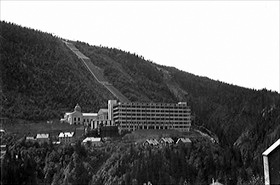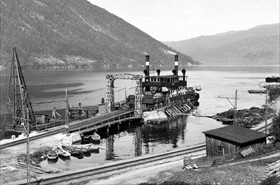U.S. B-17s DESTROY HEAVY WATER PLANT
Telemark, Occupied Norway · November 16, 1943
In the spring of 1940 Norway fell under the Nazi jackboot in a campaign that lasted 62 days and cost 5,000 lives on both sides. Three and a half years later, on this date in 1943, a massive daylight bombing raid by 143 U.S. Army Air Forces B‑17s caused extensive damage to Norway’s German-controlled Norsk Hydro’s plant near Rjukan in Telemark County. The fortress-like electrochemical and hydroelectric plant was important to the German nuclear energy project, which needed heavy water (deuterium oxide) to produce nuclear weapons. (Along with graphite, heavy water was and is a prime candidate for moderating the energy of neutrons so that it can sustain a nuclear reaction, or nuclear fission.)
Earlier in February 1943 the plant had been sabotaged by a team of British Special Operations Executive (SOE)-trained Norwegian commandos in an operation codenamed Operation Gunnerside that turned out to be the most successful act of sabotage in World War II. The entire inventory of heavy water produced during the German occupation—over 500 kilograms—was destroyed along with some critical piping and tubes. By April, however, the plant was again producing heavy water and attracting the attention of the U.S. Army Air Forces brass.
The severity of the November 16 American bombing raid and the likelihood of further Allied air raids convinced the Germans to abandon the Norsk Hydro plant and move the remaining stocks and critical components to Germany. A Norwegian saboteur thought otherwise. On February 20, 1944, Brooklyn-born Knut Haukelid, using 19 lb (8.6 kilograms) of plastic explosive, sank the railway transport ferry on Lake Tinn (Tinnsjå) and with it pretty much all of Germany’s nuclear weapons research. A largely fictional Hollywood account of the sabotage, The Heroes of Telemark (1965), starred Richard Harris as Knut Haukelid.
Even before the sinking, the number of German scientists working on applied nuclear fission had begun to shrink, with many applying their talents to more pressing wartime demands, while some were drafted into the Wehrmacht to serve (and die) on the Eastern and Western fronts. At the end of the war, the Allied powers competed to obtain surviving components of the German nuclear industry (personnel, facilities, and materiel, just as they did with the V‑2 rocket program.
![]()
The Norsk Hydro Plant and Railway Ferry
 |  |
Left: Norsk Hydro’s Vemork Hydroelectric Plant at Rjukan, Norway, in 1935. At Rjukan a large waterfall was harnessed to produce chemicals related to the production of artificial fertilizer, including ammonia, potassium nitrate, heavy water (deuterium), and hydrogen. In 1925 the plant partnered with the German company IG Farben and later with Britain’s Imperial Chemical Industries (ICI). Starting in December 1934, the Rjukan plant was the only location in Europe that mass-produced high concentrations of heavy water by means of electrolysis in the Hydrogen Production Plant shown in the foreground of this photograph. The heavy water plant was closed in 1971. Today the original power plant is an industrial museum. One of its exhibitions covers the five heavy-water sabotage operations conducted between 1942 and 1944.
![]()
Right: The twin-stack steam-powered railway ferry SF <i>Hydro</i> operated on Lake Tinn (Tinnsjå, Tinnsjø). The 19‑mile‑long ferry trip made it possible for Norsk Hydro to transport its chemicals from the plant at Rjukan to the coastal port at Skien. On February 20, 1944, the ship was blown up by the Norwegian resistance movement at Lake Tinn’s deepest point (1,411 ft) with a load of heavy water onboard headed for Nazi Germany for use in that country’s nuclear weapons program. After the war it was discovered that the Germans were not as close to making an atomic bomb as the Allies had initially feared. The wreck of the ferry and its invaluable contents were discovered in 1993.
History of Norway-Based Efforts to Sabotage German Nuclear Weapons Program
![]()

 History buffs, there is good news! The Daily Chronicles of World War II is now available as an ebook for $4.99 on Amazon.com. Containing a year’s worth of dated entries from this website, the ebook brings the story of this tumultuous era to life in a compelling, authoritative, and succinct manner. Featuring inventive navigation aids, the ebook enables readers to instantly move forward or backward by month and date to different dated entries. Simple and elegant! Click
History buffs, there is good news! The Daily Chronicles of World War II is now available as an ebook for $4.99 on Amazon.com. Containing a year’s worth of dated entries from this website, the ebook brings the story of this tumultuous era to life in a compelling, authoritative, and succinct manner. Featuring inventive navigation aids, the ebook enables readers to instantly move forward or backward by month and date to different dated entries. Simple and elegant! Click 











